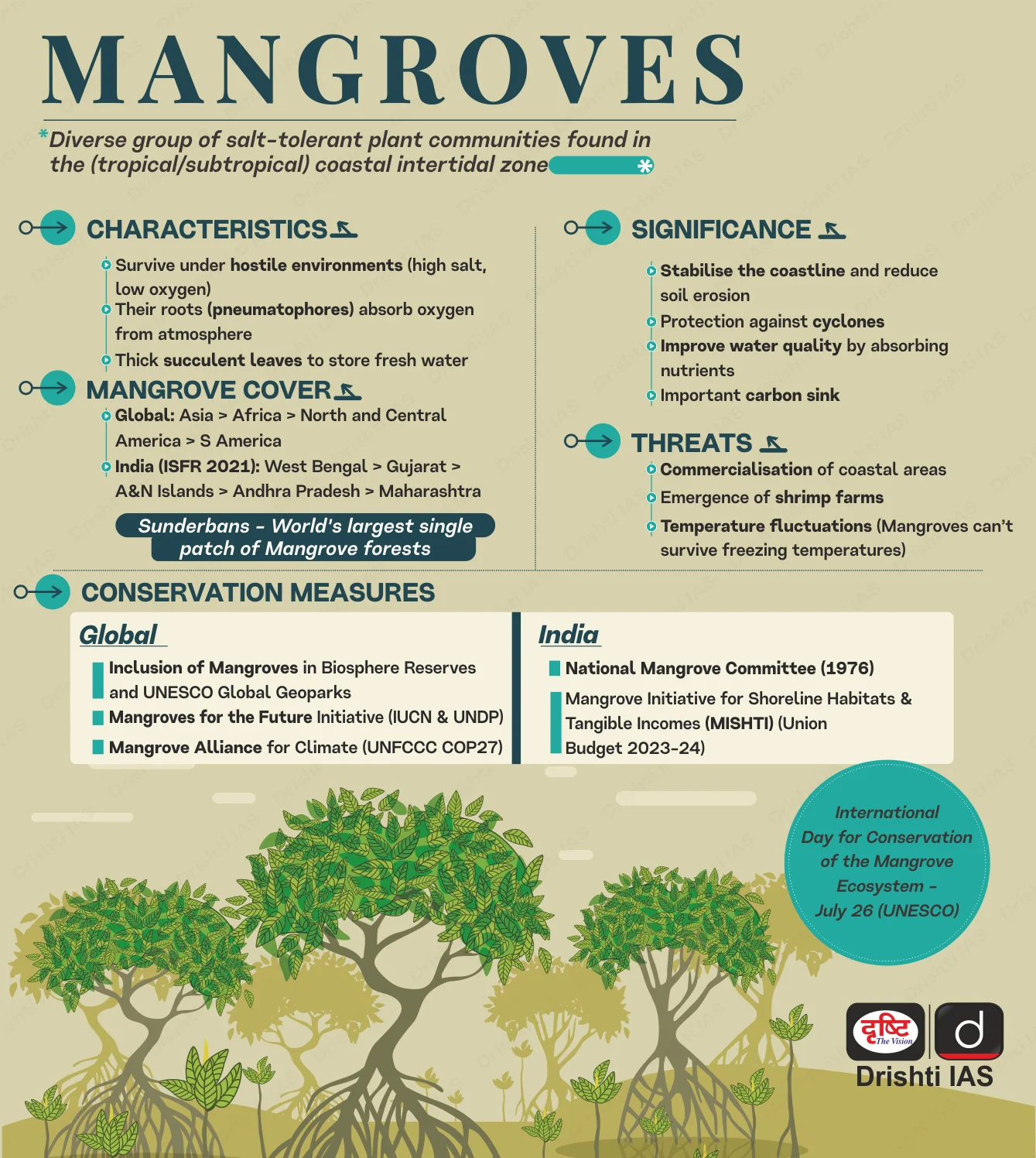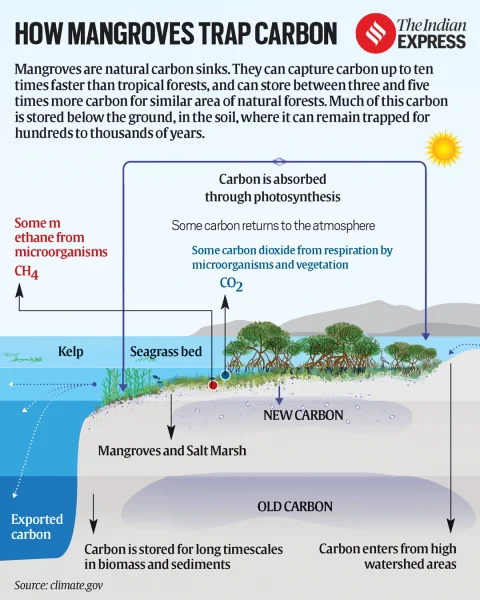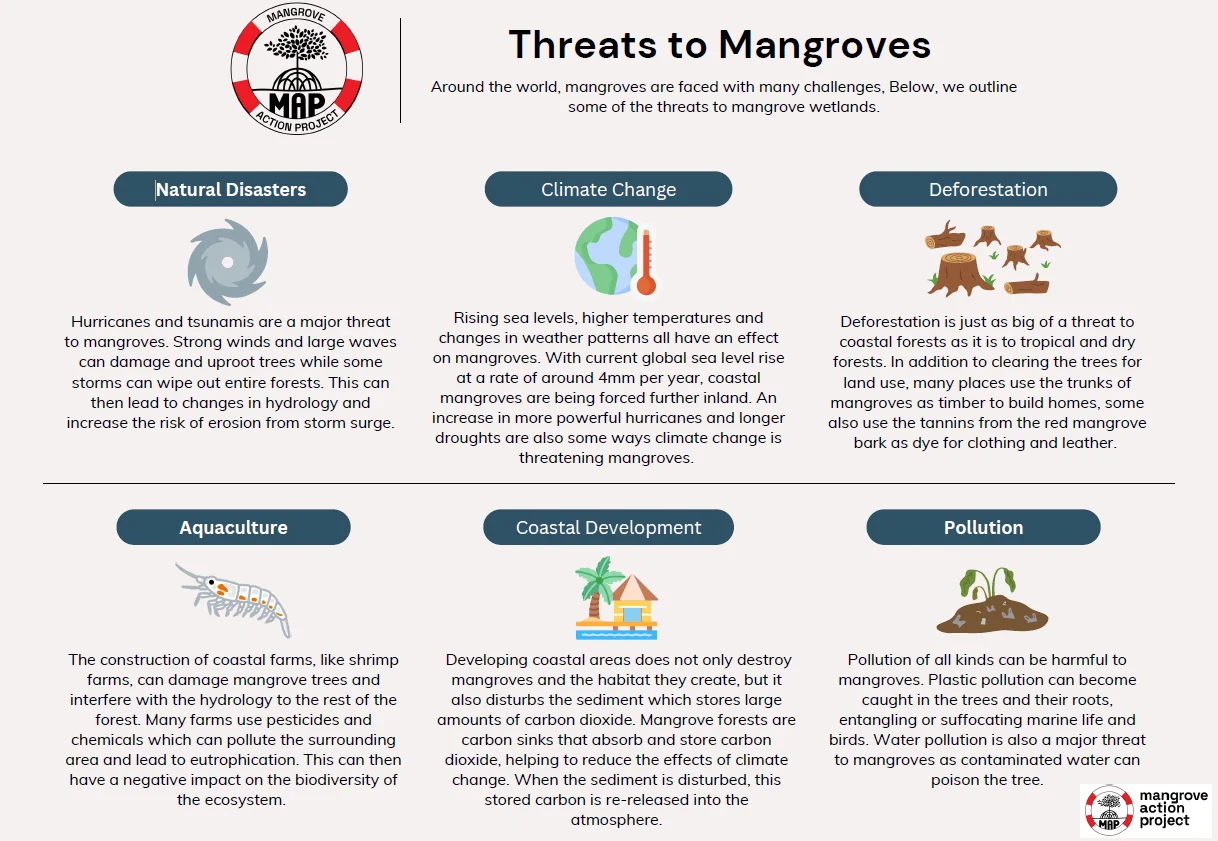International Day for Conservation of Mangrove Ecosystem | 30 Jul 2025
For Prelims: International Day for Conservation of Mangrove Ecosystem, Mangroves, Indian State Forest Report 2023, Sundarbans, MISHTI (Mangrove Initiative for Shoreline Habitats & Tangible Incomes), Sustainable Aquaculture In Mangrove Ecosystem (SAIME) initiative.
For Mains: Significance of Mangroves, Challenges Related to Mangroves in India
Why in News?
The International Day for Conservation of Mangrove Ecosystem (26th July) serves as a crucial reminder that these coastal guardians are vanishing 3-5 times faster than global forests.
- UNESCO and IUCN data reveals that global mangrove cover has halved since 1985, with 50% of remaining ecosystems now at risk of collapse.
- The Tamil Nadu Forest Department held an awareness camp, highlighting mangrove biodiversity and the Fish Bone Channel Technique for ecological restoration.
International Day for the Conservation of the Mangrove Ecosystem
- Observed annually on 26th July, this day aims to raise awareness about the significance of mangrove ecosystems as unique, special, and vulnerable ecosystems, and to promote their sustainable management, conservation, and use.
- It was adopted by UNESCO’s General Conference in 2015 to highlight the vital ecological and socio-economic roles mangroves play in coastal protection, biodiversity support, and climate mitigation.
Fishbone Technique of Mangrove Restoration
- It is a mangrove restoration method for areas with poor tidal flow, involving a central "backbone" channel and angled feeder channels to divert water from creeks.
- Once salinity and water flow are suitable, mangrove seedlings are planted. It mimics natural creeks, enhances tidal reach, and supports natural regeneration with minimal effort.
What are Mangroves?
- About: Mangroves are specialized coastal ecosystems consisting of salt-tolerant (halophytic) trees and shrubs that flourish in the intertidal zones of tropical and subtropical regions.
- They are uniquely adapted to survive in saline, low-oxygen (anaerobic) environments with slow-moving waters and accumulated fine sediments.
- Common mangrove species include Red Mangrove, Grey Mangrove, and Rhizophora, which play a crucial role in coastal protection, carbon sequestration, and biodiversity conservation.
- Mangrove Cover in India: As per Indian State of Forest Report (ISFR) 2023, India's mangrove cover is about 4,992 sq. km, accounting for 0.15% of the country’s geographical area.
- West Bengal has the largest mangrove cover in India, followed by Gujarat in second place.
What is the Significance of Mangroves?
- Carbon Sequestration: Mangroves store around 394 tonnes of carbon per hectare, exceeding most terrestrial forests, due to anaerobic and saline soils that slow decomposition.
- According to UNESCO, 1 hectare can store up to 3,754 tonnes of carbon, equivalent to removing over 2,650 cars annually.
- They uniquely lock carbon in soil for millennia, making them critical for climate change mitigation.
- According to UNESCO, 1 hectare can store up to 3,754 tonnes of carbon, equivalent to removing over 2,650 cars annually.
- Coastal Protection: Mangroves serve as natural buffers against storm surges, tsunamis, and coastal erosion acting as "bio-shields".
- Their dense root systems absorb wave energy and stabilize shorelines, reducing wave energy by 5–35% and flood depths by 15–20%, with reductions exceeding 70% during extreme storms (100-year return period), playing a crucial role in disaster risk reduction and climate resilience of coastal regions.
- Biodiversity Hotspots: Mangroves support diverse terrestrial and aquatic species across habitats like mudflats and aerial roots.
- India’s mangroves host 5,746 species (84% animals) across 21 phyla, the highest globally, including Bengal tigers, estuarine crocodiles, Indian pythons, and 260+ bird species.
- They serve as nurseries for marine life and support one-third of wild fish landings in Southeast Asia.
- Economic Significance, Food Security & Livelihood Support: Mangroves are vital to coastal economies, supporting fishing, honey collection, boating, and non-timber forest produce.
- They nurture nearly 800 billion aquatic species annually, providing nutrient-rich seafood (rich in protein, omega-3s, vitamins D & B12, iron, and zinc) and sustaining livelihoods through the blue economy.
- Mangroves also offer eco-tourism potential and play a key role in food security and human wellbeing in coastal regions.
Sundarbans: Ecological Significance, Threats & Conservation Efforts
- The Sundarbans, the world's largest mangrove forest in the Ganges-Brahmaputra-Meghna delta, holds immense ecological value as a UNESCO Biosphere Reserve and Ramsar site.
- It is a biodiversity hotspot, home to Royal Bengal Tiger, Irrawaddy and Ganges dolphins, saltwater crocodiles and crucial for coastal protection against cyclones and carbon sequestration.
- However, it faces severe threats from climate change (sea-level rise, cyclones), coastal erosion, and unsustainable livelihoods.
- Conservation efforts include increased government funding for mangrove plantations, Indo-Bangladesh climate-smart village initiatives, and community-led Joint Mangrove Management for sustainable preservation.
What are the Major Threats to Mangroves?
- Land Conversion for Agriculture: According to the "State of the World's Mangroves 2024" report, extensive conversion of mangrove land for aquaculture (26%), oil palm plantations, and rice cultivation (43%) is a major driver of loss.
- Urbanisation, infrastructure projects, and coastal tourism also lead to large-scale deforestation and fragmentation of mangrove ecosystems.
- Pollution & Industrial Activities: Oil spills, industrial effluents, and plastic waste degrade water quality and hinder mangrove regeneration.
- Cases like the Niger Delta highlight how oil contamination leads to long-term ecological damage. Timber extraction and charcoal production also contribute to degradation.
- Climate Change & Sea-Level Rise: Rising sea levels, increased frequency of cyclones, and coastal erosion due to climate change pose existential threats. As per the IUCN Red List of Ecosystems, climate change threatens 33% of mangrove ecosystems.
- Invasive Species & Biodiversity Loss: Species like Prosopis juliflora, found in Tamil Nadu and Sri Lanka, disrupt native mangrove habitats by altering soil salinity, reducing freshwater availability, and preventing natural regeneration, thereby threatening local biodiversity.
Key Initiatives Related to Mangroves Conservation
- Mangrove Alliance for Climate (MAC)
- Mangroves for the Future (MFF)
- MISHTI (Mangrove Initiative for Shoreline Habitats & Tangible Incomes)
- Sustainable Aquaculture In Mangrove Ecosystem (SAIME) initiative
- Coastal Regulation Zone (CRZ) Rules
- CAMPA Funds & National Coastal Mission
- Vana Samrakshana Samitis (Andhra Pradesh)
- Green Tamil Nadu Mission
Way Forward
- Strengthen Legal Framework: Enforce stricter laws to prevent deforestation, pollution, and unsustainable coastal development.
- Community Participation: Involve local communities through sustainable livelihoods and initiatives like “adopt a mangrove” for conservation and restoration.
- Research & Technology: Promote phytoremediation, medicinal research, and use of drones and AI for real-time monitoring and protection.
- Bio-Restoration: Rehabilitate degraded areas using bio-restoration and ensure species diversity to build climate resilience.
- Sustainable Development: Encourage eco-friendly coastal infrastructure, regulate aquaculture, and integrate mangroves into urban planning.
- International Collaboration: Leverage global platforms like the Ramsar Convention and Blue Carbon Initiative for coordinated conservation efforts.
World Nature Conservation Day (28th July)
- Celebrated annually, World Nature Conservation Day underscores the critical need for environmental protection and biodiversity conservation.
- It reinforces commitments under international environmental frameworks such as the UNFCCC, CBD, and SDGs (especially Goals 13, 14, and 15).
- The observance complements India’s LiFE (Lifestyle for Environment) initiative, advocating sustainable habits like water conservation, waste reduction, and eco-friendly mobility.
|
Drishti Mains Question: Discuss the ecological and economic significance of mangroves in the Indian context. Propose a comprehensive strategy for their conservation and sustainable utilisation. |
UPSC Civil Services Examination Previous Year Question (PYQ)
Prelims:
Q. Which one of the following regions of India has a combination of mangrove forest, evergreen forest and deciduous forest? (2015)
(a) North Coastal Andhra Pradesh
(b) South-West Bengal
(c) Southern Saurashtra
(d) Andaman and Nicobar Islands
Ans: (d)
Mains:
Q. Discuss the causes of depletion of mangroves and explain their importance in maintaining coastal ecology. (2019)






